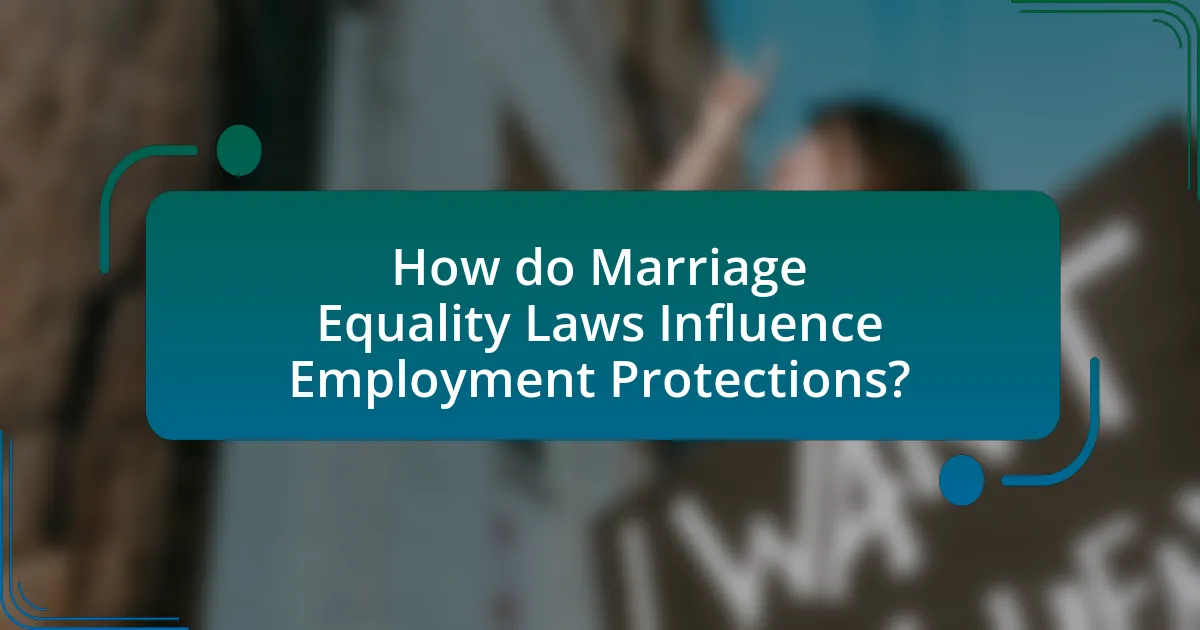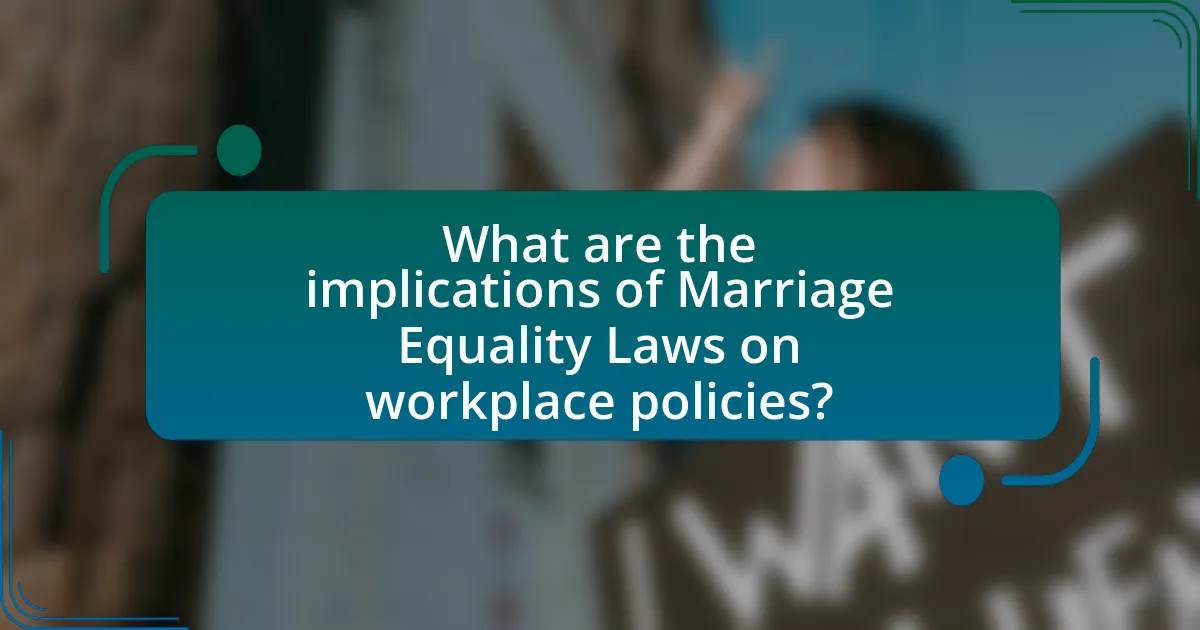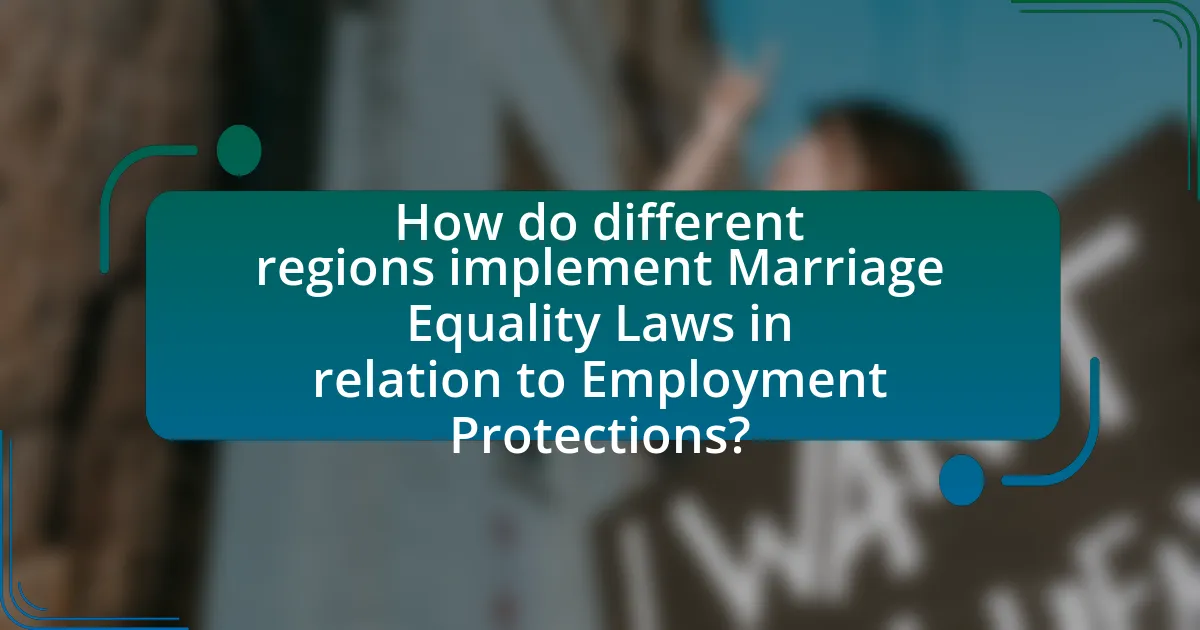Marriage equality laws play a crucial role in shaping employment protections by prohibiting discrimination based on sexual orientation and gender identity. These laws establish a legal framework that ensures equal treatment in the workplace, as exemplified by landmark rulings such as Bostock v. Clayton County and Obergefell v. Hodges. The article explores the key components of marriage equality laws, their implications for workplace policies, and the variations in employment protections across different regions. It also discusses the impact of these laws on employee benefits, anti-discrimination policies, and the overall workplace environment for LGBTQ+ individuals, highlighting the importance of compliance and best practices for employers.

How do Marriage Equality Laws Influence Employment Protections?
Marriage equality laws enhance employment protections by prohibiting discrimination based on sexual orientation and gender identity. These laws create a legal framework that ensures equal treatment in the workplace, thereby reducing instances of bias against LGBTQ+ individuals. For example, the U.S. Supreme Court’s decision in Bostock v. Clayton County (2020) established that firing an employee for being gay or transgender constitutes sex discrimination under Title VII of the Civil Rights Act of 1964. This landmark ruling illustrates how marriage equality laws can lead to broader protections, reinforcing the principle that all employees deserve a fair and equitable work environment regardless of their sexual orientation or marital status.
What are the key components of Marriage Equality Laws?
The key components of Marriage Equality Laws include the legal recognition of same-sex marriages, equal rights and benefits for married couples, and the prohibition of discrimination based on sexual orientation in marriage-related matters. Legal recognition ensures that same-sex couples have the same legal status as heterosexual couples, which is essential for accessing benefits such as tax breaks, inheritance rights, and spousal health insurance. Equal rights and benefits guarantee that all married couples, regardless of sexual orientation, receive the same legal protections and privileges. Additionally, prohibiting discrimination reinforces the principle that marriage laws must treat all individuals equally, thereby promoting fairness and inclusivity in society. These components are foundational to achieving comprehensive marriage equality and ensuring that same-sex couples are afforded the same legal protections as their heterosexual counterparts.
How do these laws define marriage in the context of employment?
Marriage equality laws define marriage in the context of employment as a legally recognized union between two individuals, regardless of gender, which grants them specific rights and protections in the workplace. These laws ensure that employees in same-sex marriages receive the same benefits and protections as those in heterosexual marriages, including health insurance, family leave, and anti-discrimination protections. For example, the U.S. Supreme Court’s decision in Obergefell v. Hodges (2015) established that same-sex couples have the constitutional right to marry, thereby extending employment benefits and protections that were previously available only to opposite-sex couples. This legal recognition impacts employer policies and practices, requiring compliance with non-discrimination laws that protect employees based on their marital status.
What legal protections do these laws provide for employees?
Marriage equality laws provide legal protections for employees by prohibiting discrimination based on sexual orientation and gender identity in the workplace. These laws ensure that employees cannot be denied employment opportunities, promotions, or benefits due to their marital status or sexual orientation. For instance, the U.S. Supreme Court’s decision in Bostock v. Clayton County established that discrimination against an employee for being gay or transgender constitutes a violation of Title VII of the Civil Rights Act of 1964. This landmark ruling reinforces the legal framework that protects employees from unfair treatment and promotes equality in the workplace.
Why are Employment Protections important in the context of Marriage Equality?
Employment protections are crucial in the context of marriage equality because they ensure that individuals are not discriminated against based on their sexual orientation or marital status. These protections help create a safe and equitable workplace environment, allowing same-sex couples to enjoy the same rights and benefits as heterosexual couples. For instance, the U.S. Supreme Court’s decision in Obergefell v. Hodges (2015) legalized same-sex marriage, but without robust employment protections, LGBTQ+ individuals could still face job loss or discrimination due to their marital status. Studies indicate that states with comprehensive non-discrimination laws report lower rates of workplace discrimination against LGBTQ+ individuals, highlighting the importance of these protections in fostering equality and inclusion in the workforce.
How do Employment Protections impact LGBTQ+ individuals?
Employment protections significantly impact LGBTQ+ individuals by safeguarding them against discrimination based on sexual orientation and gender identity in the workplace. These protections promote a more inclusive work environment, allowing LGBTQ+ individuals to pursue careers without fear of bias or retaliation. For instance, the U.S. Supreme Court’s 2020 decision in Bostock v. Clayton County established that firing an employee for being gay or transgender constitutes sex discrimination under Title VII of the Civil Rights Act of 1964. This landmark ruling reinforces the legal framework that protects LGBTQ+ individuals, leading to increased job security and workplace equality.
What role do Employment Protections play in workplace equality?
Employment protections play a crucial role in promoting workplace equality by safeguarding employees from discrimination based on various characteristics, including sexual orientation and gender identity. These protections ensure that all individuals have equal access to employment opportunities and fair treatment in the workplace, which is essential for fostering an inclusive environment. For instance, the implementation of the Employment Non-Discrimination Act (ENDA) in various jurisdictions has been shown to reduce workplace discrimination incidents, thereby enhancing equality for marginalized groups. Studies indicate that workplaces with strong employment protections report higher employee satisfaction and retention rates, further validating the importance of these laws in achieving workplace equality.

What are the implications of Marriage Equality Laws on workplace policies?
Marriage Equality Laws significantly impact workplace policies by mandating equal treatment of employees regardless of sexual orientation or marital status. These laws require organizations to revise their non-discrimination policies to include protections for LGBTQ+ employees, ensuring they receive the same benefits and rights as their heterosexual counterparts. For instance, a study by the Williams Institute found that states with marriage equality laws saw a decrease in workplace discrimination complaints, indicating a positive shift in workplace culture and inclusivity. Additionally, companies may implement training programs to educate employees about these changes, fostering a more supportive environment.
How do these laws affect anti-discrimination policies?
Marriage equality laws enhance anti-discrimination policies by explicitly prohibiting discrimination based on sexual orientation and gender identity in employment settings. These laws create a legal framework that protects LGBTQ+ individuals from unfair treatment, thereby promoting equality in the workplace. For instance, the U.S. Supreme Court’s decision in Bostock v. Clayton County (2020) established that firing an employee for being gay or transgender constitutes sex discrimination under Title VII of the Civil Rights Act of 1964. This landmark ruling reinforces anti-discrimination policies by ensuring that all employees, regardless of their sexual orientation or gender identity, are afforded the same protections against discrimination as other protected classes.
What specific protections are included in anti-discrimination policies?
Anti-discrimination policies typically include protections against discrimination based on race, color, religion, sex, national origin, age, disability, and sexual orientation. These policies are designed to ensure equal treatment in various settings, including employment, housing, and education. For instance, the Civil Rights Act of 1964 established foundational protections against discrimination in the workplace, while subsequent legislation, such as the Employment Non-Discrimination Act, has sought to extend these protections to sexual orientation and gender identity. These legal frameworks demonstrate a commitment to safeguarding individuals from unfair treatment based on inherent characteristics.
How do employers implement these policies effectively?
Employers implement policies related to marriage equality laws effectively by establishing clear guidelines and training programs that promote inclusivity and compliance. These guidelines ensure that all employees understand their rights and the protections afforded to them under the law. Training programs, often mandatory, educate staff on the importance of diversity and the legal implications of discrimination, fostering a workplace culture that values equality. Research indicates that organizations with comprehensive diversity training see a significant reduction in discrimination claims, demonstrating the effectiveness of these initiatives in creating a supportive environment for all employees.
What changes have occurred in employee benefits due to Marriage Equality Laws?
Marriage Equality Laws have led to significant changes in employee benefits, primarily by ensuring that same-sex spouses receive the same benefits as heterosexual spouses. This includes access to health insurance, retirement benefits, and family leave policies. For instance, following the Supreme Court’s decision in Obergefell v. Hodges in 2015, many employers updated their benefits packages to include same-sex couples, aligning with federal mandates that prohibit discrimination based on sexual orientation. As a result, studies indicate that companies offering equal benefits have seen improved employee satisfaction and retention rates, reflecting the positive impact of these laws on workplace equality.
How do these laws affect health insurance and family leave policies?
Marriage equality laws enhance health insurance and family leave policies by mandating equal access to benefits for same-sex couples. These laws require employers to provide the same health insurance coverage and family leave rights to employees regardless of sexual orientation, thereby promoting inclusivity. For instance, the U.S. Supreme Court’s decision in Obergefell v. Hodges (2015) legalized same-sex marriage nationwide, leading to significant changes in employer policies, including the extension of spousal health benefits and family leave under the Family and Medical Leave Act (FMLA) to same-sex spouses. This legal recognition ensures that same-sex couples can access the same health care and family leave protections as heterosexual couples, thereby improving overall health outcomes and workplace equality.
What are the implications for same-sex couples in the workplace?
Same-sex couples in the workplace experience implications related to employment protections, benefits, and workplace culture. Following the legalization of same-sex marriage in many jurisdictions, employers are increasingly required to provide equal benefits to same-sex couples, including health insurance and family leave. According to a 2020 report by the Williams Institute, states with marriage equality laws show a significant increase in workplace protections against discrimination based on sexual orientation, which enhances job security for same-sex couples. Additionally, inclusive workplace policies foster a more supportive environment, leading to improved employee morale and productivity.

How do different regions implement Marriage Equality Laws in relation to Employment Protections?
Different regions implement Marriage Equality Laws in relation to Employment Protections by enacting legislation that prohibits discrimination based on sexual orientation and marital status. For instance, in the United States, states like California and New York have comprehensive laws that protect LGBTQ+ employees from discrimination, ensuring that marriage equality is reflected in workplace policies. In contrast, regions such as Eastern Europe may have limited or no protections, resulting in a lack of legal recourse for employees facing discrimination due to their marital status. The Human Rights Campaign reports that as of 2023, 22 states have laws explicitly protecting against employment discrimination based on sexual orientation, demonstrating a significant variance in implementation across different regions.
What variations exist in Employment Protections across states?
Employment protections vary significantly across states, influenced by local laws and regulations. For instance, some states have comprehensive anti-discrimination laws that protect employees based on sexual orientation and gender identity, while others lack such protections entirely. According to the Human Rights Campaign, as of 2023, 22 states and the District of Columbia have laws explicitly prohibiting discrimination based on sexual orientation and gender identity, whereas 28 states do not have such protections, leaving employees vulnerable to discrimination. Additionally, states like California and New York have robust protections that include provisions for family leave and workplace accommodations, while states with fewer protections may not offer similar benefits. This disparity highlights the importance of understanding state-specific employment laws, especially in the context of marriage equality and its impact on workplace rights.
How do state laws differ in their approach to Marriage Equality?
State laws differ significantly in their approach to Marriage Equality, with some states fully recognizing same-sex marriage and others implementing restrictive measures. For instance, as of 2023, states like California and New York have comprehensive laws that support marriage equality, allowing same-sex couples the same legal rights as heterosexual couples. Conversely, states such as Alabama and Tennessee have enacted laws that either explicitly ban same-sex marriage or do not recognize it, reflecting a more conservative stance on the issue. This disparity in state laws affects various aspects of life, including employment protections, where states with marriage equality often provide broader anti-discrimination protections for LGBTQ+ individuals compared to those without such recognition.
What challenges arise from these variations for employees?
Variations in marriage equality laws create challenges for employees by leading to inconsistent protections against discrimination. Employees may face uncertainty regarding their rights and benefits, as some states offer robust protections while others do not. For instance, a study by the Williams Institute found that in states without comprehensive non-discrimination laws, LGBTQ+ employees are at a higher risk of workplace discrimination, affecting their job security and mental health. This inconsistency can result in employees feeling vulnerable and unsupported, ultimately impacting their overall job satisfaction and productivity.
How do federal laws interact with state-level Marriage Equality Laws?
Federal laws, particularly the Supreme Court ruling in Obergefell v. Hodges (2015), establish that same-sex marriage is a constitutional right, thereby overriding state-level marriage equality laws that may not recognize such unions. This ruling mandates that all states must grant marriage licenses to same-sex couples and recognize marriages performed in other jurisdictions, ensuring uniformity across the nation. Consequently, while states can enact their own marriage equality laws, they cannot create barriers that contradict federal mandates, as federal law takes precedence in matters of constitutional rights.
What federal protections exist for LGBTQ+ employees?
Federal protections for LGBTQ+ employees are primarily established under Title VII of the Civil Rights Act of 1964, which prohibits employment discrimination based on sex. The U.S. Supreme Court’s decision in Bostock v. Clayton County (2020) confirmed that discrimination against an employee for being gay or transgender constitutes sex discrimination under this law. This ruling provides LGBTQ+ employees with protections against workplace discrimination, harassment, and retaliation based on their sexual orientation or gender identity. Additionally, the Equal Employment Opportunity Commission (EEOC) enforces these protections, ensuring that LGBTQ+ individuals can seek recourse for discrimination in the workplace.
How do federal and state laws complement or conflict with each other?
Federal and state laws can both complement and conflict with each other, particularly in areas like marriage equality and employment protections. For instance, federal laws such as the Civil Rights Act prohibit discrimination based on sex, which has been interpreted to include sexual orientation and gender identity, thereby supporting marriage equality. However, some states have laws that may not align with these federal protections, allowing for discrimination in employment based on sexual orientation. This creates a conflict where federal protections are not uniformly applied across all states, leading to varying levels of employment protections for LGBTQ+ individuals. The U.S. Supreme Court’s decision in Bostock v. Clayton County (2020) exemplifies how federal law can override state laws that are less protective, affirming that discrimination based on sexual orientation is a violation of federal law.
What best practices can employers adopt to ensure compliance with Marriage Equality Laws?
Employers can ensure compliance with Marriage Equality Laws by implementing inclusive policies and training programs. Establishing clear anti-discrimination policies that explicitly include sexual orientation and marital status is essential, as it aligns with legal requirements and promotes a respectful workplace. Additionally, providing training for all employees on these policies fosters awareness and understanding, reducing the risk of unintentional discrimination. Regularly reviewing and updating employee handbooks to reflect current laws and best practices is also crucial, as it ensures that all staff are informed about their rights and responsibilities. According to the Human Rights Campaign, organizations that adopt these practices not only comply with legal standards but also enhance employee morale and retention.


